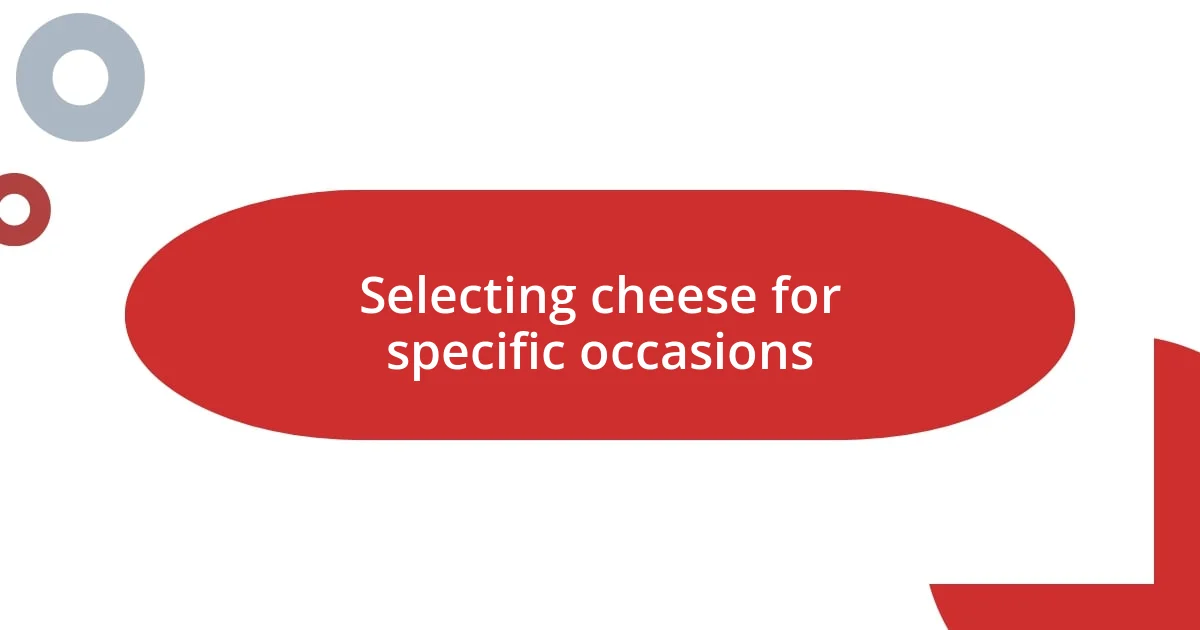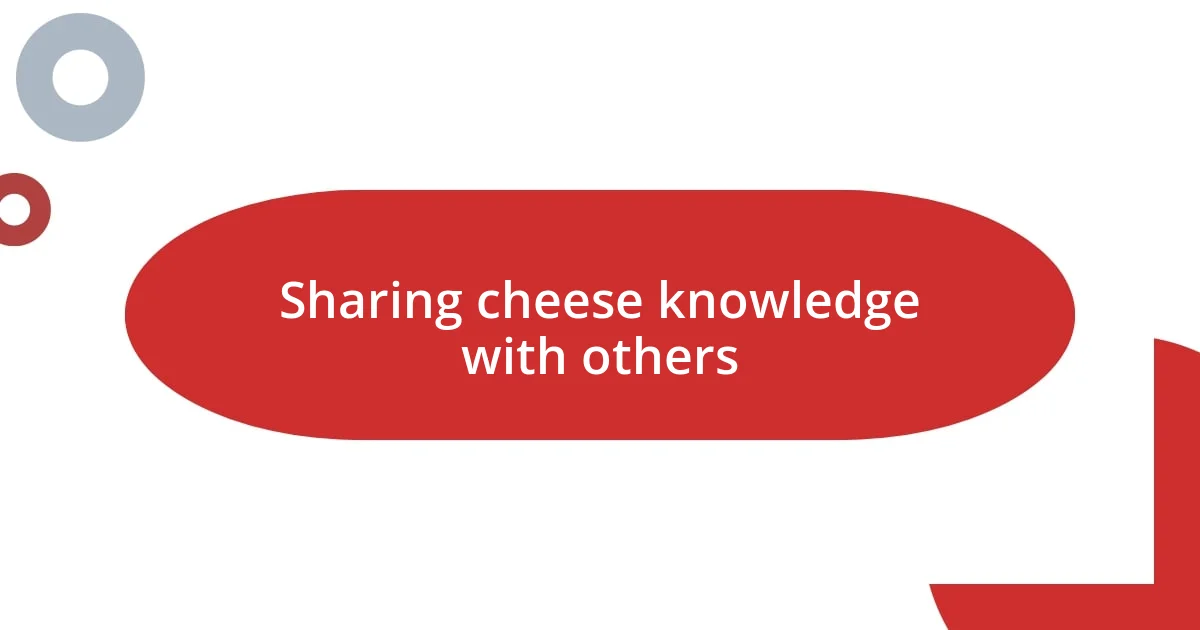Key takeaways:
- Cheese possesses unique characteristics, including flavor, texture, and aroma, which enhance the tasting experience and evoke memories.
- Regional varieties like French Camembert and Italian Pecorino reflect local culture and traditions, deepening the appreciation for cheese.
- Pairing cheese with complementary foods and creating visually appealing boards enhances social gatherings, fostering connection and conversation among guests.

Understanding cheese characteristics
When diving into the world of cheese, I find it fascinating how each variety has its own unique characteristics that tell a story. For example, crumbly blue cheese often offers a sharp, tangy taste that can evoke nostalgia for a cheese shop visit where I savored it with a glass of port. Have you ever noticed how the aroma of a cheese can shape your expectations before you even take a bite?
Texture is another crucial factor that shapes the experience of enjoying cheese. The silky smoothness of a well-aged Brie can make your mouth water, while a firmer aged Gouda invites a more deliberate chewing process. I remember hosting a cheese tasting where we paired different textures with various accompaniments, and the reactions were pure joy—each bite was an exploration of flavor and mouthfeel.
Flavor profiles are where cheese really shines, offering a delightful spectrum from mild to robust. I often encourage friends to explore cheeses with unexpected pairings, like a sweet fig jam on a sharp cheddar, to discover delightful new tastes. Have you tried experimenting in this way? It’s always a pleasure to see people’s faces light up when they find a pairing that surprises them!

Exploring regional cheese varieties
Exploring regional cheese varieties is like embarking on a delightful journey through flavors and cultures. Each region has its own distinct cheese that reflects its climate, milk sources, and local traditions. For example, the creamy, rich texture of a French Camembert instantly transports me to the lush Normandy countryside, where I once enjoyed it with a crusty baguette while soaking in the vibrant scenery. Can you imagine the depth of flavor that regional influences impart?
Then there’s the robust charm of Italian Pecorino, known for its sheep’s milk richness. Whenever I taste it, I’m reminded of a sun-drenched afternoon spent in a rustic Italian trattoria, savoring each bite while sipping on a bold Chianti. The pairing brought out such a beautiful harmony that I realized how cheese evolves into an experience shaped by its origins. Have you ever felt how a specific cheese can evoke memories of a place or moment in time?
Finally, I always find the connection between cheese and culture fascinating. For instance, meeting a local cheesemaker during my travels opened my eyes to the artisanal techniques passed down through generations. Their passion and dedication really shine through in every bite of the cheese they produce. It made me appreciate not just the product, but the story behind it. How has your exploration of cheese influenced your understanding of regional cultures?
| Cheese Variety | Region |
|---|---|
| Camembert | Normandy, France |
| Pecorino | Tuscany, Italy |
| Cheddar | Somerset, England |
| Manchego | La Mancha, Spain |

Pairing cheese with complementary foods
When pairing cheese with complementary foods, I always look for flavors that enhance and elevate each other. For instance, I once enjoyed a luscious Brie paired with roasted garlic and honey, creating a beautifully balanced bite that was both sweet and savory. The experience made me realize how thoughtfully chosen accompaniments can transform a simple cheese into a culinary masterpiece.
Here are some delightful combinations I’ve discovered along the way:
- Aged Cheddar and Apple Slices: The sharpness of the cheddar contrasts perfectly with the sweet crunch of fresh apples.
- Gorgonzola and Walnuts: The creaminess of blue cheese melds beautifully with the earthy, nutty flavors of walnuts, creating a wonderful texture.
- Goat Cheese and Beetroot: The earthiness of beetroot brings out the tangy notes of goat cheese in a refreshing salad.
- Comté and Grapes: The nutty undertones of Comté paired with juicy grapes creates a delightful balance of flavors.
- Feta and Watermelon: The saltiness of feta works surprisingly well with the refreshing sweetness of watermelon—perfect for summer gatherings.
I often find that the art of pairing lies not just in flavor but also in creating an enjoyable eating experience. Remember my last charcuterie board? I strategically placed honey drizzles next to blue cheese to draw out its intense flavors, and added a handful of toasted baguette slices for crunch. Watching friends savor each pairing, their faces lighting up with delight, was a rewarding reminder of the joy that comes from perfect pairings.

Selecting cheese for specific occasions
Selecting the right cheese for specific occasions can elevate the entire experience. I remember planning a cozy wine and cheese night with friends and wanting to create a memorable atmosphere. For this occasion, I chose soft, spreadable cheeses like a creamy chèvre and a rich double-crème Brie, paired with a light rosé. The tactile experience of spreading the cheese on artisanal crackers really sparked conversation and made the evening feel intimate. Doesn’t it feel special when the food invites everyone to share their thoughts?
When I’m tasked with bringing a cheese platter to a celebratory gathering, I love to incorporate a variety of textures and flavors. For a recent birthday bash, I selected a tangy blue cheese to contrast with the sweetness of figs and a nutty Gruyère to offer a familiar comfort. The balance of bold and mild flavors kept guests intrigued and engaged. Have you noticed how cheese can act as a social lubricant, encouraging laughter and camaraderie among friends?
For seasonal festivities, I find that using thematic cheeses adds an exciting touch. During the holidays, I curate a festive platter with a sharp aged Gouda and a spiced holiday cheese infused with seasonal herbs. The warm, inviting scent of these cheeses sets the right atmosphere for celebration. Plus, sharing stories around the table while enjoying these flavors becomes an unforgettable memory. What unique cheese selections have you made for your special gatherings?

Creating visually appealing cheese boards
Creating a visually appealing cheese board is all about artistry combined with practicality. When I arrange my cheese boards, I think of them as little canvases, where each cheese acts as a brushstroke. I recall a summer picnic where I arranged creamy, marbled blue cheese alongside vibrant slices of orange cheddar. The colors popped, making the entire spread so inviting that guests couldn’t resist taking pictures before indulging!
To elevate the aesthetics, I often incorporate fresh herbs and seasonal fruits; they add beautiful textures and flavors. For instance, I love the scent of rosemary paired with a wheel of aged gouda, and pomegranate seeds scattered about create a burst of color and taste. I once created a board featuring ripe figs and brie, which not only looked elegant but also evoked a sense of luxury. Have you ever realized how much visual appeal can transform the way we approach food?
Lastly, the arrangement is key. I prefer to use boards of various shapes and sizes to break the monotony; a rustic wooden board juxtaposed with a glossy marble platter makes for an eye-catching display. There’s something exhilarating about watching friends’ eyes light up as they explore the cheese selections. It encourages conversation and creates a shared experience. What types of presentations have you tried that turned an ordinary gathering into an extraordinary one?

Enhancing cheese tasting experiences
To truly enhance cheese tasting experiences, I’ve found that the setting plays a vital role. During one memorable rooftop gathering, I decided to set up the cheese station with fairy lights strung overhead. The soft glow created a cozy atmosphere that instantly made everyone feel at ease. Don’t you think ambiance can change the flavor of the experience itself?
Pairing cheeses with thoughtfully chosen accompaniments also transforms the tasting journey. I once prepared a tasting that featured a rich Camembert with a tart, homemade berry compote, which surprised everyone with its boldness. The combination sparked excitement and discussion about uncommon pairings. Have you ever tried an unexpected flavor that completely altered your perception of a cheese?
Engaging guests by encouraging them to share their thoughts on each cheese deepens the tasting experience. My friends and I often do mini blind tastings, where we guess flavors and textures before revealing details. It not only adds a layer of fun but also fosters connection as we learn from each other’s tastes. Have you found any interactive activities that have enriched your cheese experiences?

Sharing cheese knowledge with others
When it comes to sharing cheese knowledge, I enjoy turning each tasting into an educational experience. During a recent cheese night, I invited friends over and took the opportunity to explain the origins and characteristics of each cheese we sampled. I could see the curiosity in their eyes when I described how the distinct regions influence flavors. Did you know that the climate where the milk is sourced can significantly impact the cheese’s taste?
One memorable moment was when I demonstrated how to properly cut different types of cheese. By showing the best way to slice a wheel of gouda versus a block of cheddar, I helped my friends understand texture and serving. Each of them tried their hand at cutting, which sparked laughter and conversation. Have you ever noticed that hands-on experience makes learning so much more enjoyable?
I also love discussing flavor profiles and recommended pairings while nibbling away. For example, I once shared my enthusiasm for pairing a sharp aged cheddar with a bold merlot, and the joyful debate that followed was enlightening. Who knew that sharing cheese could lead to insightful discussions about taste preferences? It’s always rewarding to feel like we’re all learning together, don’t you agree?















